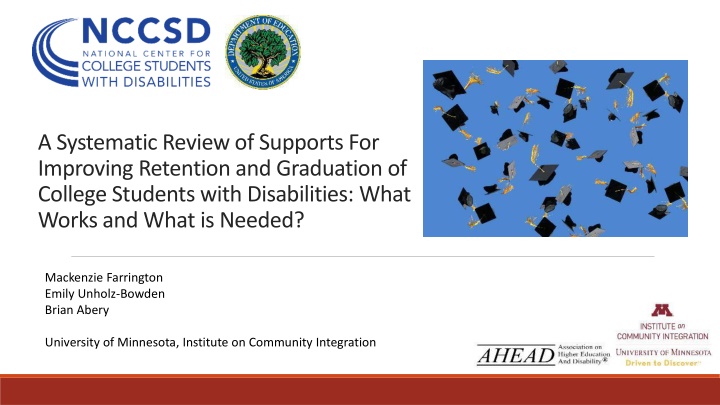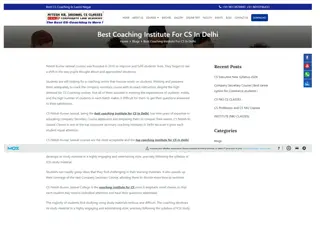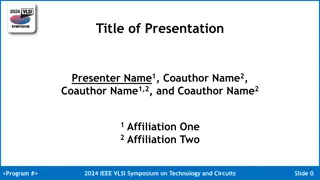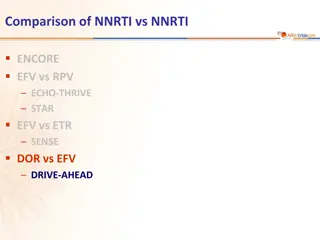
Supports for Improving College Students with Disabilities
Discover what works and what is needed to enhance the retention and graduation rates of college students with disabilities through a systematic review. This study explores the services, programs, and interventions that have been evaluated in higher education, along with the characteristics of the students involved and the academic outcomes measured. Learn about the gaps in the literature and the extent to which disability-related supports impact short- and long-term outcomes.
Uploaded on | 3 Views
Download Presentation

Please find below an Image/Link to download the presentation.
The content on the website is provided AS IS for your information and personal use only. It may not be sold, licensed, or shared on other websites without obtaining consent from the author. If you encounter any issues during the download, it is possible that the publisher has removed the file from their server.
You are allowed to download the files provided on this website for personal or commercial use, subject to the condition that they are used lawfully. All files are the property of their respective owners.
The content on the website is provided AS IS for your information and personal use only. It may not be sold, licensed, or shared on other websites without obtaining consent from the author.
E N D
Presentation Transcript
A Systematic Review of Supports For Improving Retention and Graduation of College Students with Disabilities: What Works and What is Needed? Mackenzie Farrington Emily Unholz-Bowden Brian Abery University of Minnesota, Institute on Community Integration
Background Increasing enrollment of students with disabilities (Mamboelo et al., 2020). In 2019-2020, nearly 21% of enrolled undergraduate students and 11% of graduate students reported having a disability (Digest of Education Statistics, 2022). Colleges offer a range of supports for students with disabilities, yet academic success is still much lower compared to students without disabilities. Lower GPAs Lower rate of completion of academic semester Lower graduation rates Higher dropout rates **This study was funded by the Department of Education, Office of Postsecondary Education: 3002-11245-00097446
Background: Gaps in the Literature Extent to which disability-related supports positively impact short- and long-term outcomes Differential impact of supports on outcomes based on type of disability Extent to which research findings are relevant to a diverse population of students with disabilities Quality of existing research and evaluation efforts
Study Purpose Tinto s Longitudinal Model of Student Departure: Adjusted for Students with Disabilities (Tinto, 1975; Ajaj, 2022): Available accommodations Adequacy of preparation for college
Study Purpose Conducted a systematic review to explore: Empirically evaluated services, programs, and interventions offered in higher education for students with disabilities Characteristics of students who participated in the research Academic outcomes of students measured in current research Degree to which different supports are empirically supported Quality of research conducted to evaluate these supports
Method Identified, reviewed, and extracted data from 105 U.S. studies (published 2015-2023) from peer-reviewed journals for: Services, interventions, programs, and accommodations that have been evaluated or tested via research Demographics of students with disabilities Academic outcomes measured Type of post-secondary institution Impact of different supports on academic outcomes Quality of the research methods
Student Demographics Race: Only 63% of studies reported race of student participants White (73.2% ) Hispanic or Latinx (12.2% ) Black or African American (11.4%) Asian or Pacific Islander (6.4%) Native American (0.09%) Age: Most studies included students 18 to 21 (90%) and 22 to 25 (73%). Sex/Gender: 79% studies reported participant sex Male (51%) Female (44%)
Student Demographics: Disability Of the 101 studies that reported students disabilities, the most common were: Attention Deficit and Hyperactivity Disorder (ADHD; 38.6%) Intellectual and/or developmental disabilities (ID/D; 31.7%) Specific learning disability (SLD; 29.7%), Mental health condition (28.7%), Autism Spectrum Disorder (ASD; 27.7%)
Student Demographics: Year in School Freshmen (48%) Sophomores (35%) Juniors (32%) Seniors (24%) Graduate students (20%) Undergraduate students year unspecified (31%) Juniors or seniors in high school (10%)
Settings Setting Type 4-year college or university Inclusive post-secondary education program housed within a 4- year university Non-inclusive post-secondary education program housed within a 4-year university Graduate program within a 4-year university Percentage of Studies 60% 14% 12% 8% Community or technical college 6% Non-degree granting/certification program High school and/or transition program Historically Black College or University (HCBU) or Minority Serving Institution (MSI) 1% 8% 13%
Supports and Services Supports and Services Skill building interventions Mentorship, coaching, advising, and tutoring programs Percentage of Studies 54% 37% Preparation programs for post-secondary education (PSE) or employment 18% Disability services and assistive technologies Neuro, cognitive, behavior-based, and other therapies 17% 15% Inclusive programs, activities, and organizations 6%
Supports and Services Disability type Skill building interv- entions Mentorship, coaching, advising, and tutoring programs PSE / employment prep programs Disability services and assistive technologies Neuro, cognitive, and behavior-based, therapies Inclusive programs, activities, and organizations Number of studies 56 39 19 18 16 6 ADHD 26.8% 46.2% 26.3% 38.9% 62.5% 50% ID/D 42.9% 15.3% 36.8% 22.2% 18.8% 33.3% SLD 28.6% 30.8% 21.1% 27.8% 12.5% 0% Mental health 21.4% 35.9% 21.1% 33.3% 43.8% 33.3% ASD only 21.4% 46.2% 36.8% 16.7% 6.3% 33.3% TBI/ABI 16.1% 12.8% 15.8% 33.3% 0% 16.7% Deaf/Hearing loss 10.7% 7.7% 10.5% 33.3% 6.3% 33.3% Physical Disability 10.7% 12.8% 10.5% 27.8% 12.5% 16.7% Blind/Vision loss 7.1% 12.8% 15.8% 16.7% 0% 16.7% Chronic illness 7.1% 10.3% 5.3% 11.1% 0% 16.7% PTSD 5.4% 10.3% 5.3% 5.6% 6.3% 16.7%
Academic Outcomes Regardless of disability, the reviewed research primarily included measures related to: Academic skills (52.4%) Short-term academic success (38.1%) Few studies (1.9%) measured more long-term outcomes. Other outcomes included: Career preparation (25.7% ) Recruitment (1.0%)
Research Design Research Design Single case research designs Quasi-experimental designs without a control group Percentage of Studies 33% 23% Randomized control trial Qualitative design Quasi-experimental design with a control group Correlational design Case study Secondary analysis Program evaluation or practice brief that did not include a formal research design 19% 11% 8% 7% 2% 2% 14%
Assessment of Research/Evaluation Quality Scored all studies based on 6-8 different quality indicators Quality of research design Participant representativeness of target population Appropriateness of measures Completeness of outcomes data Across all 105 studies, they received an average score of 67% of those indicators. 16
Efficacy Studies demonstrating significant or positive results: Mentorship, coaching, tutoring, and advising programs: 13 (54.2%) Skill building/acquisition interventions: 16 (49%) Postsecondary education or employment programs: 8 (67%) Disability services and assistive technology: 6 (67%) Neuro, cognitive, behavior-based, and other therapies: 7 (54%)
Overall impact of evaluated services and supports is quite mixed. Promising practices versus evidence- based practices Efficacy Need to evaluate different components of supports, programs, interventions, and services that may be effective for a student depending on individual characteristics E.g., race, disability, gender, year in school, cultural or linguistic preferences
Expanded Knowledge This review greatly expands our knowledge around the landscape of current research in academic supports for college students with disabilities. Inclusion of diverse populations in current research First to assess methodological quality First preliminary assessment of efficacy across the included disability-related supports in higher education
Limitations of the Review Several disabilities we excluded, including eating disorders and substance abuse disorder Supports and interventions designed for these populations have their own literature base Few studies related to these populations focused on academic outcomes Did not account for co-morbid conditions Unable to take into account the intersectionality between disability and various other forms of diversity
Implications For Future Research Improve research quality: Improvements in methodological rigor and more detailed reports of methodology may help provide more empirical support Future study designs and quality: Randomized control trials Quasi-experimental studies using control groups Mixed methodological studies Need greater inclusion of measures of implementation fidelity of services and supports
Implications For Future Research In future investigations, researchers should consider devoting greater attention to: Inclusion of diverse populations of students Intersectionality of disability and various forms of diversity Impact of supports and services on long-term outcomes Impact of short-term versus long-term supports
Implications for Future Research Need for more research related to: Formally testing the impact of established university programs (DRC services and inclusion programs) Evaluations of higher education supports in: HBCUs and MSIs Graduate programs Community and technical colleges High school and transition programs Evaluations of the extent to which faculty provide adequate accommodations and universal instruction
References Ajaj, R. (2022). Exploring the academic and social integration of students who are blind or visually impaired attending a Saudi Arabian university [Doctoral dissertation, University of Minnesota]. University Digital Conservancy. https://hdl.handle.net/11299/243085 Digest of Education Statistics. (2022). Table 311.10. Number and percentage distribution of students enrolled in postsecondary institutions, by level, disability status, and selected student characteristics: Academic year 2019-2020. National center for education statistics. https://nces.ed.gov/programs/digest/d22/tables/dt22_311.10.asp Rehabilitation Research and Training Center on Disability Statistics and Demographics. (2024). Annual report on people with disabilities in America: 2024. University of New Hampshire Institute on Disability. https://www.researchondisability.org/sites/default/files/media/2024-03/2024-annual-report-a11y-1.pdf Mamboleo, G., Dong, S., Anderson, S., & Molder, A. (2020). Accommodation experience: Challenges and facilitators of requesting and implementing accommodations among college students with disabilities. Journal of Vocational Rehabilitation, 53(1), 43-54. https://doi.org/10.3233/JVR-201084 Tinto, V. (1975). Dropout from higher education: A theoretical synthesis of recent research. Review of Educational Research, 45(1), 89-125. https://doi/org/10.3102/00346543045001089
Thank you! Any questions?






















